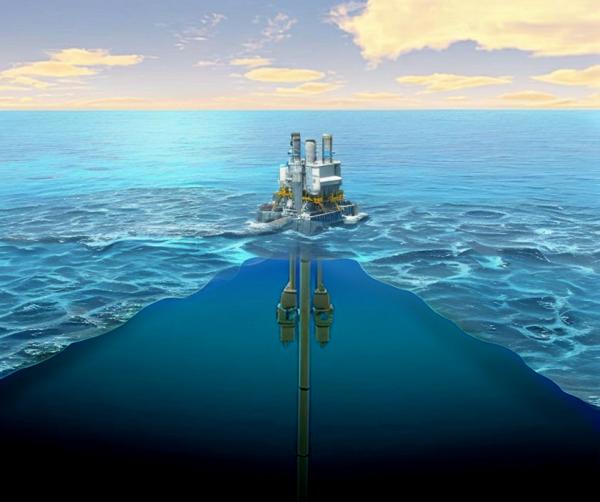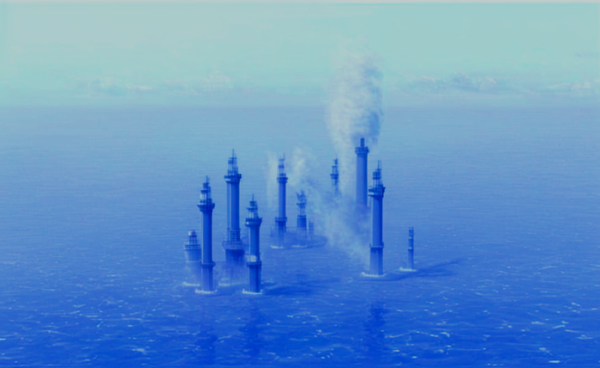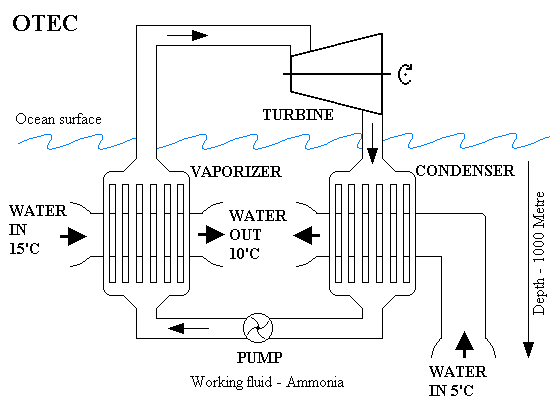BY LETTER
Ocean Thermal Energy Conversion
Technology > Application > Envirotech
Technology > Application > Infrastructure
Technology > Technology Levels > Middle Tech / Midtech
Technology > Application > Power Generation
Technology > Application > Infrastructure
Technology > Technology Levels > Middle Tech / Midtech
Technology > Application > Power Generation
Energy Extraction from Sea Water Temperature Gradients | |
 Image from Steve Bowers and Artbreeder AI | |
| OTEC installation on Atlantis, exchanging heat between water layers to generate usable energy | |
The thermocline varies with latitude and season: it is permanent in the tropics, variable in the temperate climates (strongest during the summer), and can be weak to nonexistent in the polar regions (assuming the planet's axial tilt is small enough) where the water column is cold from the surface to the bottom. All that is needed to tap into this resource is a heat engine.
The working principle of an OTEC power plant is actually very simple; the warm water is used to heat and vaporize a liquid (known as a working fluid). The working fluid develops pressure as it is caused to evaporate. This expanding vapour runs through a heat engine, such as a turbine generator, and is then condensed back into a liquid by cold water brought up from depth (the deeper the better), and the cycle is repeated. There are three basic types of OTEC power plants: closed-cycle, open-cycle, and the hybrids - various hybrids of the two.
Closed-cycle OTEC
In a closed-cycle OTEC process warm surface water vaporizes a working fluid (such as ammonia) in a heat exchanger (evaporator). The ammonia vapour is then condensed back to liquid by thermal contact with the cold water through another heat exchanger (condenser) and re-cycled. At all times, the working fluid remains in a closed system and is continuously circulated. Since ammonia vaporizes and condenses near atmospheric pressure at the available seawater temperatures, it provides a sufficient pressure drop across the turbine so that it can achieve relatively high efficiency at modest size compared to the open-cycle system.Open-cycle OTEC
In the open-cycle OTEC process seawater is the working fluid. The boiling temperature of water is a function of pressure and in the open-cycle OTEC the warm surface seawater boils inside a vacuum chamber that is maintained at a low pressure of approximately 0.34 psi. The resulting low temperature vapour (steam) flow is then directed through the turbine generator. Afterwards, the steam is chilled and condensed back into liquid by a flow of cold deep seawater from the depths. The most efficient condensation, and hence the highest electricity output, can be achieved if this steam is brought into direct contact with the cold seawater. However, if the steam flows through a surface condenser, in which it does not directly contact the cold seawater, the resulting condensate is desalinated water. This pure fresh water "by-product" is valuable for human consumption and agricultural purposes, especially in local communities where natural fresh-water supplies may be limited. The reduced efficiency of the surface condenser, however, significantly reduces the production of electrical energy from the turbine. Since the pressure drop across the turbine is the difference between the low pressure at which the water vaporizes and the lower pressure remaining after condensation, open-cycle systems require very large turbines to capture relatively small amounts of energy. In an ideal open-cycle plant, the vacuum pumps could be shut down after start-up, since all the water vaporized in the evaporator would be condensed in the condenser, leaving behind a vacuum. In the real world, however, both inevitable vacuum leaks and non-condensible gases dissolved in the surface and deep seawater necessitate continuous operation of the vacuum pumps. (a parasitic loss) An alternative open-cycle process, called "Mist Lift" avoids the necessity of a large vapour turbine, but retains the potential to provide the inherent higher efficiency of the open-cycle. The Mist Lift uses the pressure difference in an open-cycle system to lift a mist of liquid water droplets entrained in a rising vapour stream to significant elevations. The liquid water can then be separated from the vapour and pulled by gravity down through a liquid turbine, which is much more compact and more easily scaled to large power outputs.Hybrid OTEC
Another option is to combine the two processes together into an open-cycle/closed-cycle hybrid, which might produce both electricity and desalinated water more efficiently. In one hybrid OTEC system, warm seawater enters a vacuum chamber where it is flash-evaporated into steam, in a similar fashion to the open-cycle evaporation process. The steam or the warm water is then passed through an evaporator to vaporize the working fluid of a closed-cycle loop. The vaporized fluid then drives a turbine to produce electricity, while the steam is condensed within the condenser to produced desalinated water. In another hybrid system atmospheric air is used. In Arctic locations, during the winter, the seawater temperature can be 40 degrees Celsius warmer than the local air temperature. Technologies based on closed-cycle OTEC systems can exploit this temperature difference. The lack of the need for long pipes to extract deep seawater can make a system based on this concept easier than OTEC.All three types can be built on land, on offshore platforms fixed to the seafloor, on floating platforms anchored to the seafloor, or on ships that move from place to place. OTEC is macroscale technology, something that can be built by any culture in its industrial age, such as an early middle tech civilization. Of course that is only in theory.
In practice extracting usable amounts of energy from these ocean thermal layers requires higher tech levels. The temperature differences involved are only about 20 °C which means the maximum theoretical conversion efficiency, as per the carnot cycle, is only 6-7% and of course actual system conversion efficiencies are much lower, often only 1-3%, due to the high parasitic loses. (Because of the low temperature differences, and thus low efficiencies, OTEC systems have to pump large volumes of warm and cold water through their heat exchangers to get worthwhile amounts of power. This pumping takes a lot of energy and to compound the problem the heat exchangers often get fouled by biological growth.) Still the "fuel" of an OTEC is free and plentiful so there are only the "access costs" to overcome. Although it usually takes a high tech civilization to overcome these access costs and apply OTEC on a large scale it often takes an ultratech civilization to apply OTEC on a wide spread scale. This is because OTEC use at lower tech levels is more dependent on location. An OTEC system must have access to large volumes of warm and cold water to operate and access to large populations to be useful. It is often simpler to just build the OTEC plant where the thermal resource is best and then use it as a seed for a whole new city. However the more advanced a culture is the more these requirements can be relaxed. For example, an ultratech civilization could use a global network of superconducting cables and/or deploy a fleet of hypercapacitor "tankers" to transport electrical energy worldwide. An ultratech civilization can also build their OTEC systems with advanced nanofactured materials that make it easier to exploit smaller temperature differences so the OTEC plants can be sited where they are most needed.
 Image from Steve Bowers and Artbreeder AI | |
| Free-floating OTEC towers in the endless ocean of Panthalassa | |
Additional Benefits
There are advantages to OTEC that go beyond the production of clean, dependable electrical energy and often have greater value to the civilization that uses it. These include:- Fresh water production. OTEC plants can produce fresh water as well as electricity. Open-cycled and hybrid plants can directly produce fresh water as well as electricity and closed-cycle plants can produce similar volumes by condensation from the atmosphere. This is a significant advantage in island areas or deserts were fresh water is limited.
- Worldwide fuel supply. Production of fuel, such as hydrogen or biofuel from gengineered algae, by tropical OTEC plants can provide the benefits of OTEC power to a whole planet.
- Aquaculture. Deep seawater discharged from an OTEC plant is cold, rich in nutrients, relatively free of pathogens, and available in large quantity. This is an excellent medium for growing phytoplankton (algae), which in turn can support the production of a variety of fish and shellfish. Suitable mixing of the warm and cold water discharges, can provide large volume flows of seawater at any temperature between those of the surface and deep seawater, allowing temperature optimization throughout the growth cycle of cultured organisms - merely by turning a valve. Indeed aquaculture may be required to avoid potential ecological consequences. The flow of water from a OTEC plant would equal that of a major river. Since the salinity of the ocean is nearly uniform, these large discharges will not significantly affect the salinity of the receiving waters but there will be temperature differences and the resulting changes in temperature could have an impact on the local ecology, as will the increased supply of nutrients, if not contained or discharged back below the surface.
- Air-conditioning/refrigeration. The deep-ocean cold water can be used as a chiller fluid in air-conditioning systems. In the same manner OTEC technology also supports chilled-soil agriculture. When cold seawater flows through underground pipes, it chills the surrounding soil. The temperature difference between plant roots in the cool soil and plant leaves in the warm air allows many plants that evolved in temperate climates to be grown in the subtropics. This, in addition to aquaculture, can give the local population a much more varied food supply with out the added costs of a global transport system.
- Mineral extraction. Water is a weak solvent and in the oceans of a typical Gaian world every naturally occurring element can be found dissolved or suspended in them. However only six; sodium, chlorine, sulphur, magnesium, calcium and potassium make up >99% of this. Because OTEC plants will already be pumping great volumes of water, the cost of the extraction process is the only remaining factor.
- Weather modification. OTEC has the potential to change weather systems. For example, warm ocean waters feed the formation of cyclones but OTEC plants bring cold water up from the depths. Alternately, if the warm intake water, instead of the cold output water, is held in the shallow aquaculture ponds before passing through the heat exchangers it can gain a temperature raise from solar heating and cause more water vapour to enter the local atmosphere - effecting rainfall downwind of the OTEC plant. A hyperturing, in charge of tens of thousands of OTEC plants spread out across a planet, could control global weather patterns just by making small adjustments in each plant's operations.
Related Articles
Appears in Topics
Development Notes
Text by AI Vin
Initially published on 11 April 2008.
Initially published on 11 April 2008.







